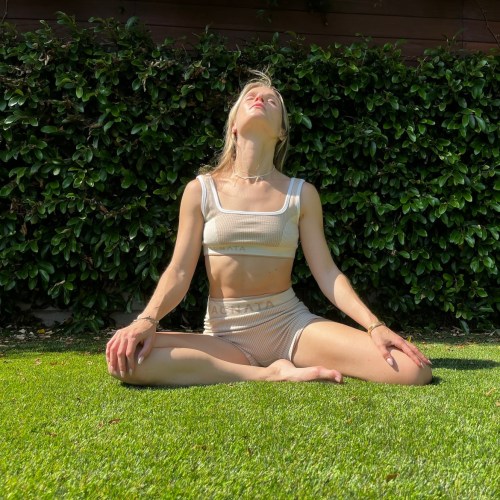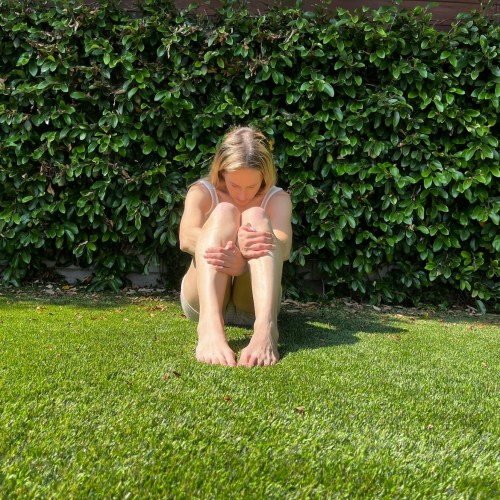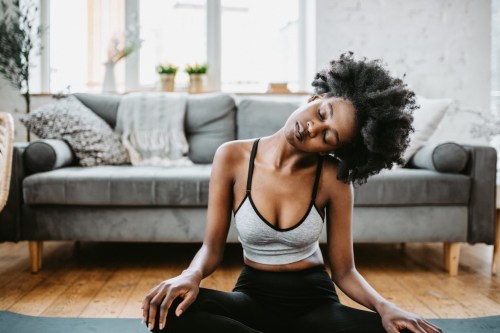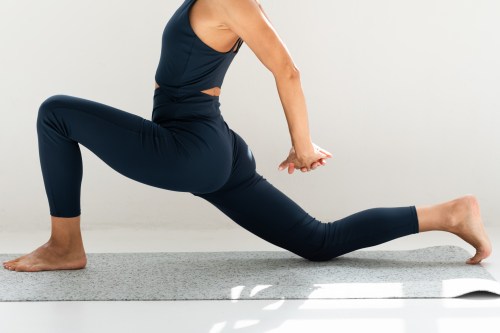There’s a reason an especially annoying situation (or person) is called a “pain in the neck.” Neck pain, while common and usually not a cause for concern, can really ruin your day.
Experts in This Article
Registered yoga teacher, Reiki master healer and tarot card reader
yoga teacher and founder of Empowered Yoga
It’s impossible to ignore; every nod, turn, and head shake offers an instantaneous reminder. Rest doesn’t always help (if you’ve ever woken up from a nap with even worse neck pain, you get it), and movement can feel risky.
Yoga, while not a cure-all for underlying injuries or medical conditions, may help provide relief for people with occasional neck pain. To better understand how to safely use yoga to loosen up tight neck muscles, we chatted with two certified yoga teachers.
Read on for their advice on using yoga to alleviate neck pain, and keep these five gentle poses in mind for the next time you wake up with a crick in your neck.
Is it safe to do yoga with neck pain?
Doing yoga with neck pain can be safe, but you need to be careful.
“The neck can be precarious,” says Rachel Hirsch, RYT-500, yoga teacher and founder of Empowered Yoga “I like to be extra safe with the neck because it’s a vulnerable area of the body that holds important parts, like arteries that supply the brain with blood.”
If you’ve sustained an injury to your neck or are experiencing intense pain, skip the asanas and see a medical professional immediately.
Otherwise, yoga can be effective and safe as long you pay attention to your body’s cues. The primary one is pain.
“If you are experiencing, at any point, additional pain, back away,” Hirsch says. “Pain is a great indicator for us that we’re doing something wrong.”
Sometimes, a yoga pose that doesn’t target the neck specifically may trigger neck pain because your body is so interconnected, according to Frances Naude, RYT-200, yoga teacher, Reiki master healer, and tarot card reader.
“For example, turning your head so that your eyes may gaze over your front fingers in warrior II pose may put too much pressure on your neck while it is rotated forward.”
If you feel any added pain in any pose, stop your yoga practice immediately.
“Yoga stretches invite deep release to muscles that are too tight from being overworked.” Frances Naude, RYT-200
The many benefits of yoga for neck pain
Increasing blood flow and oxygen to any part of your body, including your neck, can reduce inflammation and promote healing.
“Yoga stretches invite deep release to muscles that are too tight from being overworked,” Naude says, noting that an intense workout is often the culprit of neck pain.
However, you may experience that tight or “tweaked” feeling after sitting at a desk for an extended period or repeatedly carrying a baby in the same position.
Having a regular yoga practice may also offer preventative benefits, as yoga can improve your overall strength, flexibility, and range of motion.
“When your body has more strength combined with improved flexibility and mobility, it can better handle the unpredictable strains you encounter,” Hirsch says. “Additionally, yoga can assist with posture and alignment, which can reduce neck strain.”
The best yoga poses for neck pain
As demonstrated by Hirsch below, the following yoga poses help relieve neck pain by increasing blood flow in the affected area and offering a gentle stretch to the muscles in your neck, back, and shoulders.
If you’re physically active and intentional movement is part of your daily life, you may want to cycle through each pose to determine which ones feel best for your body. If you’re new to yoga and exercise, start with one or two poses.
Hirsch recommends spending five to 10 breaths in each pose, but you can adjust that according to your experience level, preferences, and how you feel in the moment.
1. Standing forward fold (Uttanasana)

- 1.Stand with your feet about hip-width apart.
- 2.Hinge at your hips to bring your torso forward and down toward your legs. Bend your knees as much as you need to.
- 3.Release your neck and allow your head to hang down.
- 4.You can place your hands on your shins or the ground in front of you. Or, for an added neck stretch, interlace your fingers at the nape of your neck and gently draw your elbows toward each other.
- 5.As you hang in a forward fold, allow for subtle movement; experiment with gently shifting your weight forward and back and side to side.
- 6.Hold for 5 to 10 breaths.
- 7.Slowly roll up to a standing position, one vertebrate at a time.
2. Neck roll

- 1.Start from a seated or standing position. Relax your shoulders and look straight ahead.
- 2.Gently tilt your head to the right, bringing your right ear toward your right shoulder. (Only go as far as what feels safe and comfortable. You do not need to touch your ear to your shoulder.)
- 3.Using a fluid, circular motion, slowly bring your chin down toward your chest. Then, slowly tilt your head up and to the left.
- 4.Slowly tilt your head back as you lift your chin toward the ceiling.
- 5.Immediately move into the next neck roll, drawing your right ear toward your right shoulder.
- 6.Continue rolling for 5 to 10 breaths, then repeat the movement in the opposite direction.
3. Seated ear-to-shoulder stretch

- 1.Start in a seated or kneeling position. Relax your shoulders and look straight ahead.
- 2.Reach over your head with your right arm and place your right palm on the left side of your head above your left ear.
- 3.Draw your right ear to your right shoulder. (Only go as far as what feels safe and comfortable. You do not need to touch your ear to your shoulder.)
- 4.You should feel a stretch on the left side of your neck.
- 5.To deepen the stretch on the left side of your neck, straighten your left arm at your side and press the heel of your left palm into the ground.
- 6.Hold for 5 to 10 breaths, then switch sides.
To further deepen the stretch, try these arm variations:
- As you draw your right ear toward your right shoulder, place your right hand by your left ear and use the weight of your arm to gently apply pressure to the head.
- As you draw your right ear toward your right shoulder, bring your arms behind your back (palms together) and interlace your fingers. Bend your elbows and bring your hands to the right so that your knuckles are resting on your right hip.
4. Cat-cow pose (Bitilasana Marjaryasana)

- 1.Start on all fours with your palms and knees on the ground. Align your elbows and shoulders over your wrists and your hips over your knees.
- 2.Slowly arch your spine, dropping your belly toward the ground. Look up as you draw your tailbone toward the ceiling.
- 3.Slowly transition into a rounded-spine position. Tuck your chin into your spine as you tilt your pelvis forward.
- 4.Alternate between an arched and rounded position for 5 to 10 breaths. Feel free to alternate with each inhalation and exhalation or move more slowly, spending an inhalation and exhalation in one position.
5. Seated embrace

- 1.Start in a seated position with your knees bent and the soles of your feet planted on the ground in front of you.
- 2.Cross your wrists and reach between your legs to grab the fronts of your shins right below your knees.
- 3.Holding your shins, round your spine (like a deep cat pose), and lean back.
- 4.Draw your chin toward your chest and lean back further.
- 5.Hold the stretch for 5 to 10 breaths.
TIP
To vary the stretch, try drawing your right ear toward your right shoulder while in a rounded spine position. Hold for 5 to 10 breaths, then switch sides.
“If something doesn’t feel good, then we don’t need to do it. All of our bodies are made beautifully different, with different experiences. What feels good in my body may not be right for yours. Trust your instincts.” —Rachel Hirsch, RYT-500
Tips to keep in mind while doing yoga for neck pain
If you’re taking a group yoga class, don’t keep your neck pain to yourself.
“Always inform your instructor before class begins that you have an injury so they may provide you with modifications throughout the class,” Naude says. “If something hurts or feels like it is causing too much strain, stop immediately! Never worry about offending your instructor or trying to keep up with the rest of the class. Yoga should be judgment-free, and it is your personal practice, so do what feels best for you.”
Also, skip any inversions or balances that put pressure on your head or neck.
Practicing at home? Listen to your body; don’t ignore pain, numbness, or uncomfortably tingly sensations. Give yourself the same grace and flexibility you’d expect from a professional.
“You have a gut for a reason,” Hirsch says. “If something doesn’t feel good, then we don’t need to do it. All of our bodies are made beautifully different, with different experiences. What feels good in my body may not be right for yours. Trust your instincts.”
When to see a doctor for neck pain
A stiff or sore neck you get from sleeping in a weird position or carrying a backpack will likely resolve on its own. That said, there’s no harm in getting checked out if you feel like something’s off.
If you have neck pain that is sharp or intense or worsens over time, you should definitely see a doctor. And, of course, any neck pain due to injury or trauma (e.g., you hit your head or get in car accident) should be evaluated by a medical professional.
Sign Up for Our Daily Newsletter
Get all the latest in wellness, trends, food, fitness, beauty, and more delivered right to your inbox.
Got it, you've been added to our email list.











